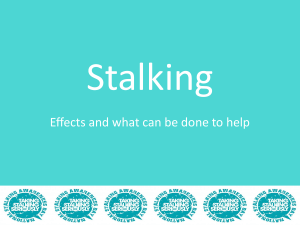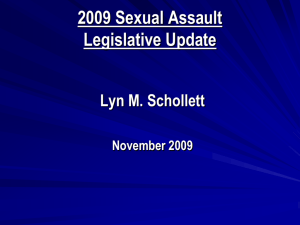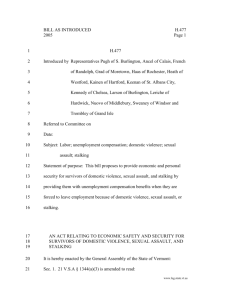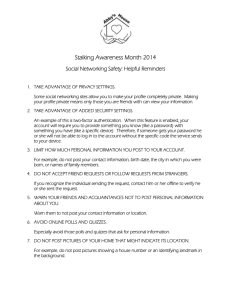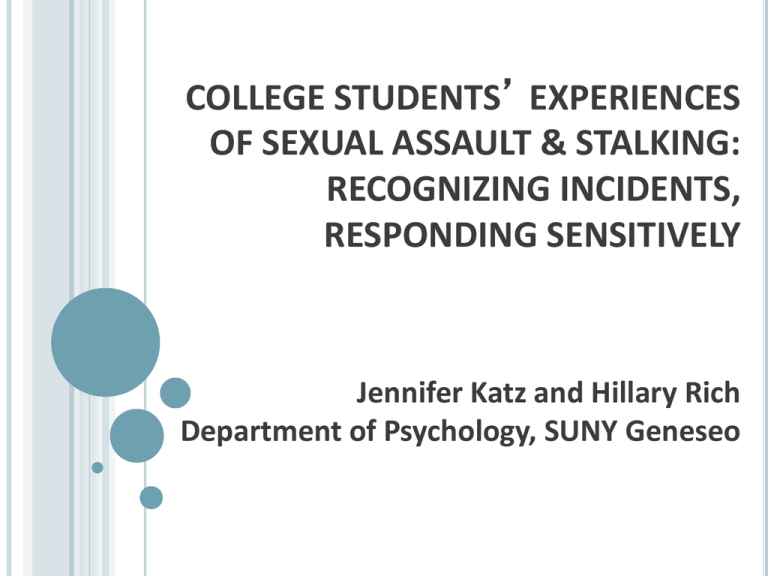
COLLEGE STUDENTS’ EXPERIENCES
OF SEXUAL ASSAULT & STALKING:
RECOGNIZING INCIDENTS,
RESPONDING SENSITIVELY
Jennifer Katz and Hillary Rich
Department of Psychology, SUNY Geneseo
CAMPUS SEXUAL ASSAULT
WHAT IS CAMPUS SEXUAL ASSAULT?
Unwanted,
nonconsensual sexual
experiences on our
campus/college
community
Violates individual
sexual autonomy
the right to refuse
sexual activity with
any person, at any
time, for any or no
reason (Schulhofer, 1998).
Sexual
autonomy is
generally not protected
in either
state law (McGregor, 2005)
or college codes of
conduct (Shapiro, 2010).
This
absence both
reflects & corroborates
tendencies to minimize
sexual assault and to
blame victims.
JUST SEX?
Collective beliefs about
normative
heterosexuality (Gavey, 2005)
Insatiable male sexual
drive; “boys will be boys”
(Weiss, 2009)
Sexual permissiveness
Stereotypes about
sexual assault
On the back: “Just
kidding”
Sex, including forced sex,
is “no big deal”
“real” assaults involve
violent strangers jumping
from bushes
Commonly, there’s no
obvious physical injury
PRESUMED SEXUAL CONSENT & VICTIM-BLAME
Among
“adults” sexual
consent is presumed unless
there’s “sufficient”
evidence to the contrary
Promotes focus on
victims: did s/he do
enough to say “no”?
Obscures focus on
offenders: did s/he act
without an unequivocal
(or even enthusiastic)
“yes”?
ARE SEXUAL RIGHTS LESS IMPORTANT?
In medicine, the presumption is of non-consent.
Victims of property crimes are not blamed in the
ways we blame victims of sexual assault:
if a drunk student can’t stop someone from taking her
car, she isn’t seen as having “consented.”
if a student willingly lends someone $10, we don’t
assume he’s willing to lend more.
Medical
and property rights are largely genderneutral; sexual violations are not.
Victims of sexual violations are often disparaged;
accordingly,
women as “sluts”
men as “weak” or “fags” - regardless of the offender’s sex
(Valenti, 2010)
(Rogers & Davis, 2006)
JUST “BAD SEX”?
Victims
of sexual assault tend to minimize their
experiences, blame themselves, or both, especially if
Alcohol was involved (by self or offender or both)
decreases offender blame while increasing victim blame!
They know the offender or are romantically involved
Perpetration involved oral penetration or penetration
by objects other than a penis (Kahn, 2004)
Most
campus sexual assaults involve
Alcohol (Shapiro, 2010),
People who know each other – 80-90% (Karjane et al., 2005)
A NATIONWIDE PROBLEM
American
College
Health Association
(ACHA)
Projected that 20-25%
of women experience
attempted or
completed rape in
college
and rates increase
when including
contact (sexual
battery)
(Carr, 2005).
National
Institutes of
Justice (NIJ)
19% of women, 6% of
men experienced
attempted or completed
rape since beginning
college (Krebs et al., 2007)
Less then 5% reported
sexual violations to any
campus authority
(Karjane, Fisher & Cullen, 2005).
UNDER-REPORTING: RECIPROCAL EFFECTS
Individual
minimization
victims are often embarrassed, worried about
privacy, & fear punishment for underage drinking
(Karjane et al., 2005).
The
Center for Public Integrity found US campuses
Often fail to document sexual assaults
Often fail to support victims; are “intimidating,
unsympathetic or unlikely to result in punishment
for the accused” (Lombardi, 2009)
In 2006, 77% of schools reported zero sexual offenses
From 1988-2009, SUNY New Paltz held 3 hearings; one
student was found guilty and punished
Can improve their responses to victims, which
decreases under-reporting (Lombardi, 2009)
BEHAVIORALLY SPECIFIC QUESTIONS
Neutral
Objective
Allow the student to focus on personal experience,
not the match between their experience and
stereotypes
In the Geneseo anonymous campus wide survey of
1701 students, we asked
Behaviorally specific questions from the Sexual
Experiences Survey
“Have you been sexually assaulted at Geneseo”
Who did you tell?
SES: NONCONSENSUAL CONTACT/BATTERY
Since starting college, at Geneseo, how many times have
you been fondled, kissed, or touched sexually when you
didn’t consent to it because
1. you were overwhelmed by another person’s continual
arguments and pressure?
20% overall, 24% of women, 10% of men
2. a person used a position of authority (your boss,
teacher, counselor, supervisor) to make you?
1% overall, no sex differences
3. a person threatened or used some degree of physical
force (twisting your arm, holding you down, etc.) to
make you?
6% overall, 7% of women, 2% of men
SES: SEXUAL COERCION AT GENESEO
4. Since starting college,
at Geneseo, how many
times have you given
into sexual intercourse
although you didn’t
consent to it because
you were overwhelmed
by a person’s *continual
arguments and
pressure*?
9% overall
11% of women
4% of men
5. Since starting college,
at Geneseo, how many
times have you had
sexual intercourse when
you didn’t want to
because a person used a
position of *authority*
(as your boss, teacher,
camp counselor,
supervisor) to make you?
< 1 % overall
No sex differences
SES: ATTEMPTED RAPE AT GENESEO
Since starting college, at Geneseo, how many
times has a person *attempted* sexual
intercourse (but intercourse did not occur) when
you didn’t consent to it…..
6. and the person was
7. by giving you alcohol
threatening or using
or drugs without
some degree of force
your knowledge or
(twisting your arm,
consent?
holding you down,
4% overall
etc.)?
5% of women
4% overall
2% of men
5% of women
1% of men
SES: RAPE SINCE STARTING COLLEGE, AT GENESEO, HOW MANY TIMES HAVE
YOU
8. had sexual intercourse when you didn’t consent to it b/c a
person gave you alcohol or drugs w/o your knowledge or
consent? (2% overall)
9. been incapacitated due to alcohol or drugs (that is, passed out
or unaware of what was happening) and were not able to
prevent unwanted sexual intercourse from taking place?
o
8% overall, 9% of women, 6% of men
10. had sexual intercourse when you didn’t consent to it b/c a
person threatened or used some kind of physical force (twisting
your arm, holding you down, etc.) to make you? (2% overall)
11. had *sex acts* (e.g., penetration by objects) when you didn’t
want to b/c a person threatened or used some degree of
physical force (twisting your arm, holding you down, etc.) to
make you? (1% overall)
A)
T
ABLE
1:
OVERALL
RATES
AT
GENESEO
(N
=
1683
____________________________________________________________________________________________
Overall
Women
Men
(n = 1228)
(n = 455)
____________________________________________________________________________________________
Any SES experience
25.5 (429) 29.6 (363)
14.5 (66)
20.9 (352) 25.0 (307)
9.9 (45)
(% yes, number of students)
Any Sexual Contact
(sexual touch w/o consent)
Any Sexual Coercion
9.2 (155)
11.0 (135)
4.4 (20)
6.8 (114)
8.4 (103)
2.4 (11)
9.4 (158)
10.0 (123)
7.7 (35)
(nonconsensual penetration)
Any Attempted Rape
(attempted penetration)
Any Rape
(penetration due to force
or incapacitation)
_______________________________________________________________________________________________
Notes: a Excludes those who didn’t indicate their sex (n = 14) and trans students (n = 4); 13.2% had > 1 type
TABLE 2: STUDENTS WHO SELF-IDENTIFY AS SEXUALLY ASSAULTED
AFTER REPORTING BEHAVIORALLY SPECIFIC INCIDENT
________________________________________________________________________________________
Have you ever been sexually assaulted on campus
or in the Geneseo community?
% Yes % Unsure % No
________________________________________________________________________________________
Sexual contact
5.5
4.1
90.4
10.2
3.4
86.4
28.3
11.7
60.0
30.4
10.8
58.9
(n = 146)
Sexual coercion
(n = 59)
Attempted rape
(n = 60)
Completed rape
(n = 158)
_________________________________________________________________________________________
Notes: 5% of the total sample (N = 1683) identified as sexually assaulted at Geneseo;. Row
percentages are based only on students classified as to their most severe SES event.
TABLE
3: RATES OF DISCLOSURE TO CAMPUS PERSONNEL
_________________________________________________________________________________________________________
Any Assault
(n = 366)
Severe Assault
(n = 213)
Identified Assault
(n = 79)
% (n)
% (n)
% (n)
_________________________________________________________________________________________________________
Tell any staff?
Tell > 1 office?
Specific offices told
Campus health
Residence staff
Dean of students
UP/campus police
Geneseo faculty
Other staff
8.2 (30)
2.5 (9)
12.7 (27)
3.8 (8)
17.7 (14)
11.4 (9)
4.7 (17)
4.1 (15)
2.2 (8)
1.4 (5)
0
<.01 (1)
7.5 (16)
6.1 (13)
3.8 (8)
1.9 (4)
0
.01 (1)
12.7 (10)
10.1 (8)
10.1 (8)
5.1 (4)
0
0
_________________________________________________________________________________________________________
Note: Sample sizes within each column vary based on prevalence rates and how many
students responded to the question “If any of these experiences happened, who did
you tell about what happened? Please mark all that apply.”
CAMPUS STALKING
WHAT IS STALKING?
Use
of pursuit behaviors: repeated, unwanted
intrusions that present a threat and/or cause
the victim fear or concern
Distinct from courtship or flirting
Stalker’s attempt to contact the victim or create a
relationship ignores the rights and interests of the
victim (Emerson et al., 1998)
Anyone can become a potential victim of stalking
Generally,
an explicit threat is necessary for
police involvement
TYPES OF STALKERS
Erotomaniac
stalker
Stalker believes s/he loves & is loved by the victim
No prior relationship between the stalker & victim
exists
Love-obsessional
stalker
Stalker recognizes that his/her love isn’t
reciprocated
Stalker meets the criteria for a DSM diagnosis
Simple-obsessional
stalker
Stalker pursues a victim with whom s/he has had a
previous relationship
Most common form of stalking (Zona et al., 1993)
SIMPLE-OBSESSIONAL STALKERS
Stalking
often occurs after a romantic breakup
Although men & women can be targets, the typical
profile is a women pursued by a male ex-partner
(Jones, 1996)
Same-gender stalking is a relatively rare, understudied
phenomenon
Ex-partner
stalkers are more likely than others to
exhibit threats and violence
Typically use multiple forms of harassment & intimidation
The more emotional investment, the more risk of violence
Stalking is part of the spectrum of domestic violence
Goals
of stalking: revenge and/or reunification
Motives can evolve (Langhinrichsen-Rohling et al., 2000)
IDENTIFYING RISK FOR STALKING: VICTIM
EXPERIENCES IN THE RELATIONSHIP
Characteristics
of the
Ex-Partner:
Jealous
Possessive
Hypersensitive
Dependent on partner
Physically and/or
emotionally abusive
Wanted to become too
serious too quickly
(Jason et al., 1984)
Stalking
may have
occurred during the
relationship
The victim may have
reconciled before
with the stalker
This may have
inadvertently
reinforced the
stalker’s pursuit
behavior
(Fremouw et al., 1997)
EFFECTS OF STALKING ON THE VICTIM
Victims
of stalking often display reactions
similar to other victims of trauma, including
domestic violence
Stalking is an ongoing rather than isolated incident,
creating protracted stress
Reported
feelings of victims:
powerless
violated
a lack of control
apprehensive
severe emotional trauma (Jones, 1996)
These
attitudes may potentially lead to victims
to become socially isolated
STALKING AS A NATIONAL PROBLEM
A
When participants
were not required to
experience fear,
prevalence rates rose
to 12% and 4%,
respectively (Tjaden &
Thoennes, 1998)
National Prevalence Rates of
Stalking Victimization
20
Percentage
national survey
revealed lifetime
prevalence rates of
being stalked as
8% of women
2% for men
15
10
Met legal
criteria
5
0
Women
Men
Participants
Did not meet
the fear
requirement
STALKING ON COLLEGE CAMPUSES
Rates
of stalking on college campuses are much
higher than in the general population
30% of women & 17% of men reported being stalked
Only 1% reported perpetrating stalking (Fremouw et al., 1997)
Although
common, students may not accurately
recognize risk
Students are learning appropriate courtship behavior
and how to navigate romantic relationships
College students are in a developmental stage
characterized by beliefs of invulnerability
College
students are less likely to report stalking
Stalking may be more of an issue than campus security
realizes
TABLE 3: STUDENT REPORTS OF EXPERIENCING STALKING
BEHAVIORS AFTER A ROMANTIC BREAKUP (N = 137)
Type of behavior
Occurred
once
Occurred multiple
times
Ex-partner found out information about you by
means other than asking you directly (i.e. asked
friends about you, or contacted your family)
53%
46%
Ex-partner made exaggerated claims of
affection for you
54%
42%
Ex-partner refused to accept the relationship
has ended, or claimed to still be in a
relationship
41%
32%
Ex-partner verbally abused you (i.e. using
obscene or threatening language)
41%
32%
Ex-partner made unwanted phone calls or
hang-up phone calls to your home, school, or
workplace
38%
35%
Ex-partner spread false rumors about you
37%
25%
CYBERSTALKING ON SOCIAL MEDIA
Online
pursuit allows a stalker to
pursue a victim without his or her
awareness & to make anonymous
contact
Twitter
Facebook
The internet inhibits social anxiety
Stalkers may feel more confident online
(Meloy, 1998)
Most
Foursquare
Tumblr
state laws require in-person
contact for behavior to be
considered stalking
Cyberstalking can be psychologically
damaging to the victim, even if the
victim isn’t physically threatened
(McEwan et al., 2007)
COMMONALITIES AMONG STALKING BEHAVIORS:
VIOLATING BOUNDARIES
Stalking
violates multiple rights & boundaries:
Right to romantic and sexual autonomy
A past relationship, regardless of its nature, does
not entitle an ex-partner to future contact or
access
Right to privacy, both in person and online
Right to feel (and be) safe
Even when stalkers don’t explicitly threaten
victims, their controlling and persistent
behaviors can be distressing
Some stalkers target friends & family members
as well
SOCIAL RESPONSES
SOCIAL REACTIONS
Specific responses to disclosure or
knowledge of an event, including sexual
assault or stalking
Two primary types of social reactions
Positive AND negative
NEGATIVE SOCIAL REACTIONS
Can be purposeful attempts to harm
survivors
However, typically unintentional
Can also include lack of any response at all
The main categories include
Victim Blame
Distraction
Stigmatizing
Egocentric Responses
Controlling Responses
VICTIM BLAME
Blaming the survivor for being assaulted or stalked
Behavioral Blame
Blame the survivor’s behaviors
“You were not careful” or “You drank too much”
My parents said that the way I dressed and the
friends I chose provoked the incident; I wasn’t
careful enough
Characterological Blame
Blame on the survivor’s character or personality
“You are a weak person” or “You have bad judgment”
My friends asked how I didn’t see it coming and
how I could be so stupid
DISTRACTION
Discouraging the survivor from talking
about the assault or stalking
Includes avoiding the topic or changing the
subject
May imply that the survivor is not coping
adequately or is overreacting
Someone told me that if I dwell on this, the
person who did this to me is winning.
My mom just wanted me to forget.
STIGMATIZING
Reflect
rejection of the survivor that is due to
the stigma of sexual assault or stalking
Verbal or behavioral responses that treat the
survivor differently or like “damaged goods”
My brothers, who I told, handle me like I am about to
break.
Show that survivors can lose relationships
My mother disowned me
EGOCENTRIC RESPONSES
Responding in self-focused ways that reflect the
responder’s concern about the effect of the assault
or stalking on themselves
Often from family members or romantic partners
May deny the survivor’s immediate needs or
impede his or her ability to receive support/help
My boyfriend asked too many questions, asked for too
many details; things I didn’t want to share at the time
Threatening the perpetrator may reinforce
feelings of helplessness or fear
My father said, ‘I’d like to kill the guy’
CONTROLLING RESPONSES
Trying to take control of the survivor or postassault or stalking situation
Authority figures (parents, police, medical
providers) may respond this way, includes
Treating the survivor like a child
Knowing “better than” they do
Over-ruling their decisions or wishes
My father treated me as if I was 5 years old
instead of 25
MORE NEGATIVE RESPONSES
Minimizing Response
Suggesting it wasn’t that bad; could’ve been worse,
suggest the victim invited, enjoyed or caused it
She said at least I didn’t have it as bad as other victims
They said it was flattering to have all that attention
Disbelief/Denial
Suggest/imply it was “just sex” or “flirting”
Trust Violation
Betraying survivor’s trust via actions or
statements
EFFECTS OF NEGATIVE SOCIAL
REACTIONS
Increased
psychological symptoms
PTSD, depression, guilt, anxiety
Poorer perceived health
Reluctance to seek appropriate help
May silence survivors
POSITIVE SOCIAL REACTIONS
support
survivors with respect for their wishes
(victim-centered); 3 main types
emotional support
listening respectfully, with care
support, validate the survivor’s feelings (then & now)
you said no; that should’ve been enough
instrumental support/tangible aid
providing medical or counseling services such as
HIV testing, emergency contraception
information support
My counselor at college provided information and resources
during my years in session with her
MORE POSITIVE REACTIONS
Non-blame
Stating that it was not the survivor’s fault
Listening
Taking time to pay attention, listen carefully
gave me a change to talk, didn’t question me like an
authority
Using survivors’ language
If s/he refers to “the incident,” you do so as well
Avoid labels, unnecessary questions
Not all survivors think of themselves as victims or
their experiences as sexual assault or stalking
SENSITIVE RESPONDING TO STALKING
Recognize
the greatest potential danger: the ex-partner
stalker who makes threats
Address safety concerns first
Until a victim feels safe, hypersensitivity & mistrust are
adaptive
Ultimate
goals: alleviate associated psychological
distress, rebuild the victim’s trust and confidence
Advice for victims:
Tell friends and family to maintain a social network (may
become additional targets)
Keep a log documenting all contact and surveillance
Seek police involvement
Avoid confrontations and do not engage with the stalker
QUESTIONS?

